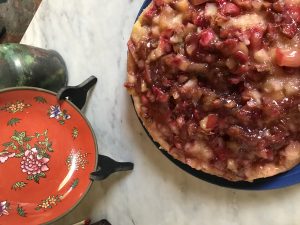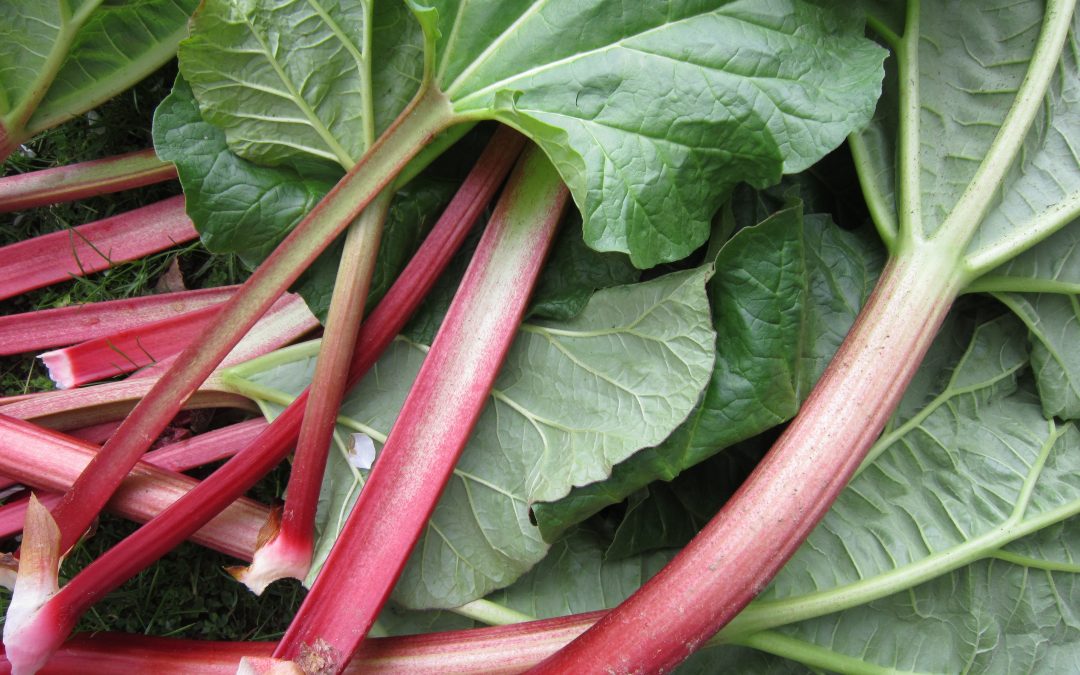
This rhubarb in my yard is not ready for picking yet. I like to have the stalks a bit longer before I harvest them.
By LAURA GROSS-HIGGINS
It’s that time of year when everything is returning to life. In my garden, I look forward to having fresh rhubarb again.
Rhubarb, which is a perennial, has been used for both cooking and medicinally for thousands of years. Originating in Asia and appearing in this country in the 1600s, the ancient Chinese used it medicinally and its use was primarily that for many hundreds of years. Philadelphian John Bartram was growing it in this country in the 1730s. Whenever it came here, it is now an established part of our cuisine. It is an herbaceous stalked plant whose stalks are used for cooking and baking, with the latter use greatly tipping the scale.
Rhubarb, or Rheum rhabarbarum, does have health benefits. It is a source of vitamin K, which is important in bone health and for clotting, according to the website Nourish by WebMD. It also has Vitamin A, and is high in antioxidants, and other vitamins and minerals. It is low in calories, with only 13 calories in a 1/2 cup raw serving, although because of its tartness, we tend to pair it with sugar. Vitamin K can interfere with blood thinning medications, so if you are planning to incorporate it into your diet, that fact is good to know.
The leaves contain oxalic acid, which can have adverse health effects, causing diarrhea, nausea, and vomiting, if ingested. The season for rhubarb here is from April to June. The plant likes cooler climates. Rhubarb does best in places in which the average temperature falls below 40ºF (4°C) in the winter and below 75ºF (24°C) in the summer, the website for the Old Farmer’s Almanac says.

Rhubarb Tea Cake
As a child, I can remember my siblings “borrowing” rhubarb stalks to eat. My stepmother was not really a pie maker, so we never had a strawberry rhubarb pie. One of the nicknames for rhubarb is the “pie plant.” That’s because its tart flesh makes a perfect pie filling when paired with sugar and strawberries.
But there are many ways to take advantage of this seasonal fruit, which is really a vegetable. Generally, I have harvested it mostly in the spring, in May and June and then let the plant stay untouched for the rest of the summer. One of the websites I looked at said to stop harvesting it in July and let it replenish itself for the next year. According to “The Joy of Gardening Cookbook,” by Janet Ballentyne, if the plant flowers, just cut off the blooms and the plant will keep producing. She also said the plant should be divided every four or five years.
I was told by a friend that one should harvest it by pulling on a leaf near the base of its stem. You have to give it a good tug. It’s also better to get the whole stem out by pulling. It has a round bottom edge, almost like the way a fingernail looks. And you should pick the outer leaves, not the ones near the center of the plant, because the plant grows from the inside out. If the plant is only producing thinner stalks, it is time to stop picking.
Once they are harvested, I trim the leaves from the picked stalks and use only the stems. Depending on the recipe or the width of the stalk, I may remove some of the ribs (like on celery) that seem to stick out when I am cutting the rhubarb into pieces.
In 2012, I wrote an article for an Enterprise magazine on rhubarb. In that one, I shared a recipe for rhubarb used as a sauce for poached fish, which I am going to include again here. For this article, I do have some new recipes. One is for a rhubarb tea cake that I love. I got it off the web but don’t remember where.
I enjoy it because in the process of making it, I make a rhubarb syrup that I love on yogurt. And the solids from making that are also good.
Rhubarb Tea Cake
The unreduced syrup is good for cocktails or rhubarb sodas. Reduced, it can be tossed with strawberries or other fruits or used over ice cream. The time it takes to reduce depends on the width of the pot and heat used. You need about 1 pound (500 g) of rhubarb for this.
Serves 6
Cake:
1½ cups all-purpose flour
1 tsp baking powder
½ tsp salt
½ cup softened butter, cubed
1 cup granulated sugar
2 eggs
¼ cup whipping cream (I use evaporated milk)
1 cup chopped rhubarb
Syrup:
1 cup sugar,½ cup water, 4 cups chopped rhubarb
Preheat oven to 350°F.
Place parchment paper in base of a loaf pan. Butter the sides of the pan and sprinkle sugar to coat sides.
Sift together flour, baking powder and salt in a bowl. Stir in butter, sugar, eggs and cream. Beat with an electric mixer for 3 minutes or until mixture is smooth and some air has been incorporated. Stir in rhubarb. Scrape into loaf pan. Bake for 45 to 55 minutes or until top is golden and a cake tester comes out clean. Allow to cool in pan for 10 minutes. Place cake on rack; remove paper and return still warm cake to pan.
Combine sugar, water and rhubarb in a pot while cake is baking. Bring to a boil, then simmer 15 minutes or til rhubarb is very soft. Strain mixture into a clean pot, pressing down on solids. Discard any solid rhubarb or use for a very thick rhubarb jam.
Rebring the liquid mixture to a boil and simmer for c. 10 to 15 minutes or until reduced to syrup. You will have about ⅓ cup. While cake is warm, make holes on top with a wooden skewer. Brush or pour over about 2 TBSP syrup. Reserve the remainder. Cool.
Cut cake into thick slices to serve. Slice in half. Place 2 halves on a plate, drizzle syrup around and top with crème fraîche or vanilla ice cream.
Salmon in Rhubarb Sauce
1 lb rhubarb
4 c. cold water, divided, or 3 c. cold water and 1 c. dry red wine (I used rose)
2 tsp unflavored gelatin (optional)
4 ounces plain tomato sauce (half an 8 ounce can)
1 tsp salt or to taste (optional)
1 TBSP vegetable oil
1 TBSP sugar (I used 2 TBSP)
2 lbs salmon, cut into 1- to 1-1/4-inch steaks (cooked whole, then cut)
6 leaves of lettuce or julienned lettuce
Chopped scallions
Fresh ground pepper
If the rhubarb is tough, peel off the heavy filaments, and cut into 1-inch pieces. In a large, squat pot, cook the rhubarb over medium low heat in 3 ½ c. (or 3 ¼ c. if frozen) or 2 ½ c. of the water and 1 cup wine for 20 or less or until the rhubarb is very soft. The frozen rhubarb requires less cooking.
Meanwhile, sprinkle the gelatin over the remaining ½ c. of water and let it soften for 5 minutes.
When the rhubarb is done, stir in the gelatin mixture or the remaining ½ c. water (if you don’t use the gelatin), the tomato sauce, salt (if desired), oil, and sugar. Simmer for 5 minutes.
Add the fish steaks, submerging them in the sauce. Cover the pot and poach for 15 minutes or until the fish is just done. Adjust the seasonings.
Remove fish from the sauce with a large slotted spatula and place the steaks in a baking dish with sides. Pour the sauce over the fish and chill overnight.
Now divide the steaks into 6 serving pieces, putting each on a single leaf or a bed of julienned leaves and chopped scallions. Put some of the sauce on top. Grind pepper on top and serve with tsatziki (a cucumber-yogurt sauce).

